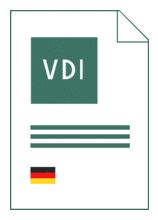Standards Worldwide
Standards Worldwide
Phone +49 30 58885700-07

Technical rule [CURRENT]
VDI 3783 Blatt 10:2010-03
Environmental meteorology - Diagnostic microscale wind field models - Air-flow around buildings and obstacles
- German title
- Umweltmeteorologie - Diagnostische mikroskalige Windfeldmodelle - Gebäude- und Hindernisumströmung
- Publication date
- 2010-03
- Original language
- German, English
- Pages
- 52
- Publication date
- 2010-03
- Original language
- German, English
- Pages
- 52
Product information on this site:
Quick delivery via download or delivery service
Buy securely with a credit card or pay upon receipt of invoice
All transactions are encrypted
Short description
The dispersion of atmospheric contaminants in the vicinity of anthropogenic sources gains more and more importance in expert practice. Emission sources can be for instance road-traffic as well as odours. Such emissions are often released in built-up areas. Here the dispersion path is strongly influenced by obstacles. The guideline represents an important component in modelling these complex dispersion relations. A simulation model is described in the guideline enabling the user to simulate the mean and three-dimensional wind field over a smooth surface in the area of obstacles like buildings, trees and dams. The typical dimensions of the computational domain are between some decametres up to some kilometres. The objective of the guideline ranges from supplying three-dimensional wind fields for dispersion simulations to planning the measuring net for flow measurements in centre city areas and to analysing possible wind field changes caused by building operations. The method described is based on mass conservation. The dynamic flow effects are reached by adequate input data for an initial wind field. These so-called diagnostic models need very little storage capacity and computational time so that large areas with a highly spatial resolution can also be simulated on a personal computer as well.
Content
ICS
13.040.01
Replacement amendments
This document replaces VDI 3783 Blatt 10:2001-12 .
Also available in
Loading recommended items...
Loading recommended items...
Loading recommended items...
Loading recommended items...
